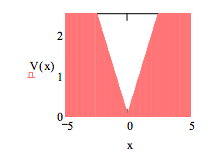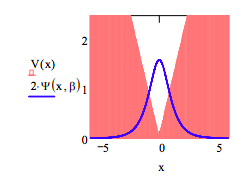10.14: Variation Method for a Particle in a 1D Ice Cream Cone
- Page ID
- 136251
Define potential energy: V(x) := |x|
Display potential energy:

Choose trial wave function: \( \Psi (x, \beta ) := \sqrt{ \frac{ \beta}{2}} sech( \beta x)\)
\[ E ( \beta ) := \int_{- \infty}^{ \infty} \Psi (x, \beta ) \frac{1}{2} \frac{d^2}{dx^2} \Psi (x, \beta ) dx + \int_{- \infty}^{ \infty} V(x) \Psi (x, \beta )^{2} dx \nonumber \]
Minimize the energy integral with respect to the variational parameter, \( \beta\).
\( \beta\) := 2 \( \beta\) := Minimize( E, \( \beta\)) \( \beta\) = 1.276 E( \(\beta\)) = 0.815
Display wave function in the potential well.

Calculate the probability that the particle is in the potential barrier.
\[ 2 \int_{0}^{ \infty} \Psi (x, \beta )^2 dx = 1 \nonumber \]
Define quantum mechanical tunneling.
Tunneling occurs when a quon (a quantum mechanical particle) has probability of being in a nonclassical region. In other words, a region in which the total energy is less than the potential energy.
Calculate the probability that tunneling is occurring.
\[ |x| = 0.815 |_{float,~4}^{solve,~x} \rightarrow {\begin{pmatrix}
0.8150 \\
-0.8150
\end{pmatrix}} \nonumber \]
\[ 2 \int_{0.815}^{ \infty} \Psi (x, \beta )^2 dx = 0.222 \nonumber \]
Calculate the kinetic and potential energy contributions to the total energy.
Kinetic energy:
\[ \int_{- \infty}^{ \infty} \Psi (x, \beta ) -( \frac{1}{2}) \frac{d^2}{dx^2} \Psi (x, \beta ) dx = 0.272 \nonumber \]
Potential energy:
\[ \int_{- \infty}^{ \infty} V(x) \Psi (x, \beta )^{2} dx = 0.543 \nonumber \]

